Hello everyone! It's a light week for new products, but we still have enough to talk about and show you. There are certainly enough cool things in here to make someone excited. So let's see what we have in the video for this week.
The conductive fiber has a peculiar texture. It feels like a cross between silk and steel wool. In any event, I'm curious to see what people end up using it for.
First off, just want to post a reminder of the SparkFun Simon Sketch Class taking place this coming Tuesday, October 11th. In this class, you'll learn how to turn you Simon into a drawing tool on your computer. Add a breadboard, a few dials, an FTDI connection to processing, and you're ready to go. This class is designed for people with some Arduino experience, but little to no experience in processing. Bring your own Simon and we'll get to hacking!
Many of you might be familiar with our 'Pro' series. We have the Arduino Pro and the Arduino Pro Mini. Essentially, they are stripped down versions of the regular Arduino which makes for a cheaper board which is easier to embed. They have been very successful and I tend to use a Pro Mini in almost any one of my own projects. Now we have a Pro version of the Mega. The Pro Mega is similar to the Mega 2560, but does away with the barrel jack, USB section, and headers. What you have left is a very slim board that can still accept shields, but runs at 3.3V so you can use it with a LiPo battery.
Fiber optics are neat. They are an easy way to transport light from one place to another quite efficiently. This fiber optic cable can do exactly that. It's 5 meters in length and about 3.25mm in diameter. Strip back the jacket to expose the 64 individual fibers. The size makes it easy to heat-shrink a 3mm LED on to one end.
For all you e-textile fans out there, we have a new product for you. If you've ever wanted to make your own conductive thread, yarn, or even felt, you might want to check out this conductive fiber. It's a raw fiber made from stainless steel and can be woven into whatever you want, and even mixed with other fibers to create your own threads or yarns.
So remember that illuminated rotary encoder we talked about awhile back? Well maybe this will jog your memory. I promised we'd have a breakout board for the encoder and here it is. Add a circular bargraph and a rotary encoder and you have a great input device with visual feedback.
So, that's it for this week. I will make you one promise. For those of you who actually enjoy the 'entertainment' portion of these posts (and video), you might want to check back next week, we have something planned. We'll see you again next week and thanks for reading!
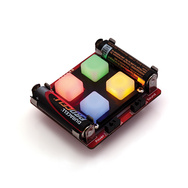
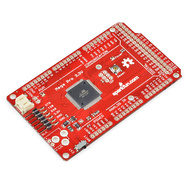
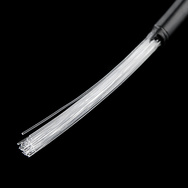
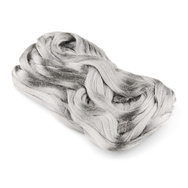
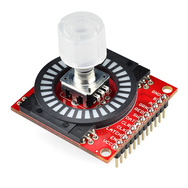






Rob's hands are actually fairly accurate calipers, giving measurements down to fractions of a millimeter. See them in action at 1:59
Well, when you work with measurements like that on a regular basis you kind of get the hang of it. I build models and measurements in the neighborhood of a couple mm are pretty common in that work. I can spot the difference between 3mm and 1/8" (3.175mm) - which is an important distinction for what I do. So I could see being able to recognize that a fiber is more than 3.5mm in diameter but less than 4.0mm without using a measurement tool.
Not only that, but they're metric too!
edit: oops, you already said he used millimeters.
Is the video up of Tim and the prank you guys pulled on him from 2 weeks ago? I've been constantly checking your Youtube page for it!
Did anyone else see the stuff in the soldering station move around while he said "here's what we got for this week?"
I think he bumped to table.
I think it was a poltergeist.
Just a nit-pick : Taking fiber and making it into thread or yarn is Spinning (sometimes combined with Plying), not Weaving. Weaving is taking yarn or thread and making it into fabric by interlacing (typically on a loom). Knitting and Crochet both take yarn or thread and turn them into a fabric using specialized stitches (effectively knots).
That conductive fiber looks like Grandmas hair!?
Rapunzel! Rapunzel! Let down your conductive hair!
I wonder if you could weave it into somebody's hair.
It really DOES look a lot like hair, up close as well, although it's finer, and bears a lot more resemblance to wool roving :)
Can I get a 5v version of the Pro Mega? I have sensors and everything else designed at 5v as my applications are around the house they remain plugged in via wall wart.
Wait it seems as though it accepts up to 12v DC... are the v+ pin headers regulated 3.3, well specifically the aref pin? I guess I could just power this after a regulator and split power to my sensors bofore the board.... make me a 5v very please ;) I'll probably end up getting one of these in the next cpl weeks great product idea, are we going to get a mini Mega? That would be great!
It looks like you could add a 5 volt regulator. (I'm looking at the schematics, NOT the Eagle files so I could be wrong.) You would need to cut the trace between the 3.3 volt and the 5 volt pins though. You can't use the Lipo after modding. Might get you by until the 5 volt version comes out.
Many years ago I was working on a project to braid medical implants. The braiding technology was very sophisticated requiring custom CNC machines and they could braid 3D shapes and seamless eyelets at will etc. with each fiber working it's way 3D through out the structure. To develop the machine we worked with a contractor in VA and with Drexel University's textiles lab. They were braiding structural preforms of crazy things like submarine propellers and rocket nozzles from carbon and metal fibers and they had an example of an I-beam from stainless steel fiber. The SS felt as soft as silk and the beam preform was fairly flexible. Of course it was extremely rigid once a matrix was vapor deposited in the pores. E-textiles is another cool and unusual application for supple metal fibers. Thanks!
Heck yeah! Love it!
Forget the new products, I want to see video of the Viking funeral.